We are extremely lucky to live in a state that is blessed to have the closest warm waters to Antarctica.
Each year from May until early October, our region’s spectacular coastline is renowned as being prime spotting territory for humpback whales, southern right whales, blue whales and orcas as they make their annual pilgrimage from the feeding grounds of Antarctica to give birth and raise their calves in Australia’s warmer waters.
It’s simply stunning to witness these majestic creatures, and in a time where things seem so dark, what could be better than to hit the road and catch a stunning glimpse of the giants of the ocean.
Warrnambool
At just over two hours from Geelong and three from Melbourne, you’ll stumble upon Warrnambool, one of Victoria’s best whale watching locations between June and September. Well-known as nursery for southern right whales, Logan’s Beach (off Hopkins Point Road) will be your best bet to see these majestic creatures and their babies too. The whales often swim within a hundred metres of the shore, and can be viewed from a huge, specially constructed platform in the sand dunes. You can also try the sheltered waters in Lady Bay, where the new mums often come close enough to spray you with breakwater. The protected bay is perfect for the gentle giants to give birth and raise their calves so there are good odds of catching a glimpse.
You can call the Visitor Information Centre or head to Visit Warrnambool beforehand for whale sighting updates. Sometimes whales may not be visible at Logans Beach, even though they are in the region so make time for multiple visits.
Portland
Located three and a half hours from Geelong, Portland is one of Victoria’s premier whale watching destinations, with southern right whales visible off the coast from Cape Bridgewater to Narrawong. You can head out into the Portland harbour, or make your way out west to Cape Bridgewater to see these giants of the sea on their annual migration through the Southern Ocean. If you go down to the Port of Portland on a good day you might be lucky enough to witness the whales play within metres of the Lee Breakwater. Other great viewing spots include the cliffs above Nuns Beach and Portland Bay and the lookout on Wade Street.
Hot tip: If the whale flag is flying outside the Portland Visitor Information Centre, there is a very, very good chance visitors will catch a glimpse of southern right whales.
View this post on Instagram
Check out more travel related content via our website.
Great Ocean Road
If you’re looking for a sighting close to home, the 243km drive along the Great Ocean Road provides many prime whale spotting vantage points with designated parking spaces off the road. The beaches in Torquay and Lorne are known for occasional visits, however taking to the high-up lookouts will give you a better chance of viewing from afar. There’s a lookout at Anglesea just above the main beach, and another one on the cliff at Split Point Lighthouse in Aireys Inlet that provides prime viewing.
You can stay apprised of recent whale sighting on the Great Ocean Road by visiting the road’s official tourism website.
Apollo Bay
While most certainly part of the Great Ocean Road, Apollo Bay is well-known in the region for its abundance of whale sightings in the winter season. A two-hour drive from G-town, it’s possible to see whales, especially Southern Rights, from the Apollo harbour and Apollo Bay beach where they come as close as 100 metres to the shore during the day and evening. The pods tend to stick around for a week at a time before heading to their next destination.
View this post on Instagram
Phillip Island
An ideal location for a weekend away, Phillip Island offers visitors the chance to see humpback whales, southern right whales and orcas as they make their long journey along the Victorian coastline. For low cost viewings, grab your binoculars and try your luck down at Cape Woolamai, Surf Beach, Pyramid Rock, The Nobbies or the Summerlands area, which all offer great whale watching opportunities. Southern right whales can also sometimes be seen in the shallow waters off Cowes or San Remo jetty. Although humpback and southern right whales are more prevalent, orcas do occasionally visit the waters around Phillip Island. You’ve got better chances if you head out on the water and join a tour, but dry land can definitely provide the goods if you try these areas.
Call ahead to the Phillip Island Visitor Information Centre at Newhaven for information on the latest sightings.
Looking for a quick trip?
If you’re not one for long drives you could consider jumping on Searoad Ferries, which operates two all weather car and passenger ferries between Sorrento and Queenscliff. Not only is it the most scenic way to get from Mornington Peninsula to the Bellarine, but because of the large stretch of coastline around Queenscliff, travellers have a better chance off sighting a whale than they might have in other coastal towns.
The most common whales in the area are Humpback and Southern Right Whales.
You can find out more here.
Lastly, know what you’re looking for
Do a little research before you head off on your whale adventure and see if you can pick out the different species from where you’re standing. Humpback whales are lighter and move faster than the southern right whale, boasting a unique white underside, long flippers, and a small dorsal (back) fin. Southern right whales are usually black, do not have a dorsal fin, and have a rounded blow hole. Orcas (or Killer Whales as they’re often known as) are much smaller, have distinctive black and white colouring, and are the fastest swimmers of all the cetaceans, reaching speeds of more than 50km/h while hunting.

